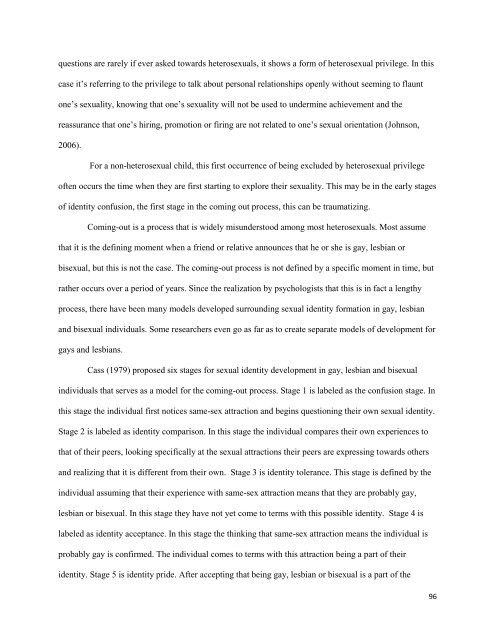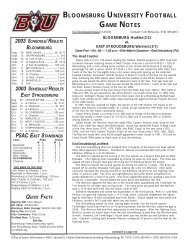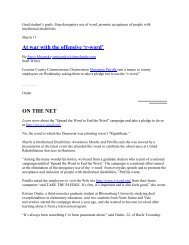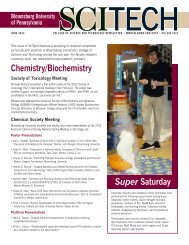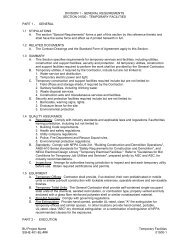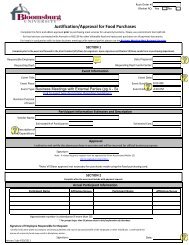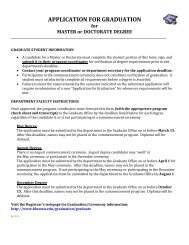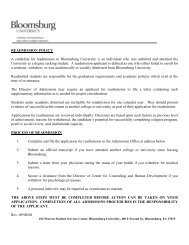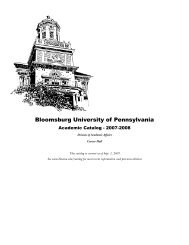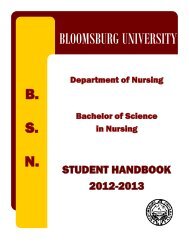Human Rights at Home and Abroad: Past, Present, and Future
Human Rights at Home and Abroad: Past, Present, and Future
Human Rights at Home and Abroad: Past, Present, and Future
You also want an ePaper? Increase the reach of your titles
YUMPU automatically turns print PDFs into web optimized ePapers that Google loves.
questions are rarely if ever asked towards heterosexuals, it shows a form of heterosexual privilege. In this<br />
case it‘s referring to the privilege to talk about personal rel<strong>at</strong>ionships openly without seeming to flaunt<br />
one‘s sexuality, knowing th<strong>at</strong> one‘s sexuality will not be used to undermine achievement <strong>and</strong> the<br />
reassurance th<strong>at</strong> one‘s hiring, promotion or firing are not rel<strong>at</strong>ed to one‘s sexual orient<strong>at</strong>ion (Johnson,<br />
2006).<br />
For a non-heterosexual child, this first occurrence of being excluded by heterosexual privilege<br />
often occurs the time when they are first starting to explore their sexuality. This may be in the early stages<br />
of identity confusion, the first stage in the coming out process, this can be traum<strong>at</strong>izing.<br />
Coming-out is a process th<strong>at</strong> is widely misunderstood among most heterosexuals. Most assume<br />
th<strong>at</strong> it is the defining moment when a friend or rel<strong>at</strong>ive announces th<strong>at</strong> he or she is gay, lesbian or<br />
bisexual, but this is not the case. The coming-out process is not defined by a specific moment in time, but<br />
r<strong>at</strong>her occurs over a period of years. Since the realiz<strong>at</strong>ion by psychologists th<strong>at</strong> this is in fact a lengthy<br />
process, there have been many models developed surrounding sexual identity form<strong>at</strong>ion in gay, lesbian<br />
<strong>and</strong> bisexual individuals. Some researchers even go as far as to cre<strong>at</strong>e separ<strong>at</strong>e models of development for<br />
gays <strong>and</strong> lesbians.<br />
Cass (1979) proposed six stages for sexual identity development in gay, lesbian <strong>and</strong> bisexual<br />
individuals th<strong>at</strong> serves as a model for the coming-out process. Stage 1 is labeled as the confusion stage. In<br />
this stage the individual first notices same-sex <strong>at</strong>traction <strong>and</strong> begins questioning their own sexual identity.<br />
Stage 2 is labeled as identity comparison. In this stage the individual compares their own experiences to<br />
th<strong>at</strong> of their peers, looking specifically <strong>at</strong> the sexual <strong>at</strong>tractions their peers are expressing towards others<br />
<strong>and</strong> realizing th<strong>at</strong> it is different from their own. Stage 3 is identity tolerance. This stage is defined by the<br />
individual assuming th<strong>at</strong> their experience with same-sex <strong>at</strong>traction means th<strong>at</strong> they are probably gay,<br />
lesbian or bisexual. In this stage they have not yet come to terms with this possible identity. Stage 4 is<br />
labeled as identity acceptance. In this stage the thinking th<strong>at</strong> same-sex <strong>at</strong>traction means the individual is<br />
probably gay is confirmed. The individual comes to terms with this <strong>at</strong>traction being a part of their<br />
identity. Stage 5 is identity pride. After accepting th<strong>at</strong> being gay, lesbian or bisexual is a part of the<br />
96


